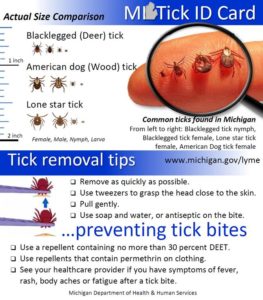The sounds of spring are wonderfully noisy: birds calling, squirrels chattering, the buzzing of sleepy bees, and woodpeckers drilling into trees. Everyone is hungry, including ticks. That’s why you should take measures to protect yourself, your children, and your pets from ticks and Lyme Disease. Here is a quick primer and a link to a lot more information.

Before you go outside
- Know where ticks hitch a ride (wooded brushy areas with high grass and leaf litter) and walk in the center of trails.
- Treat clothing and gear with permethrin (apply only to clothing, never to your skin).
- Use insect repellents that contain 20% or more DEET on exposed skin. Concentrations of more than 30% DEET should not be used on children under 2 years of age.
- Wear light-colored clothing and long pants tucked into your socks.
Do a tick check after each outing
- Check your clothing for ticks (lint rollers are a great tool for quick checks).
- Examine your gear and pets carefully for ticks. Consider treating dogs ahead of time with preventatives available through your veterinarian.
- Shower within 2 hours and check your body for ticks.
Tick attached?
- Stay calm. If your child has a tick, a five minute distraction, like a good story or video, helps.
- Use tweezers or your fingers to grip the tick, as close to the skin as possible, applying slow, even pressure; it can take up to three minutes for the tick to back out.
- Do not twist the tick. Do not use Vaseline or the tip of a hot match to attempt to make a tick back out.
- Preserve the tick in a small jar with some alcohol. Keep it, in case you need to ID it later.
- Wash the bite area and your hands thoroughly with soap and water.
- If you think the tick was attached for more than 18 hours, seek care from a medical professional right away—and bring the preserved tick to your appointment!
- Watch for symptoms. Contact your doctor if you have a fever, rash, body aches, or fatigue.
Here is a video showing an expert removing a tick from the Lyme Disease Association.
For ID help and more tips, go to the MDHHS website’s page about ticks and Lyme Disease.
Solutions to Ticks, the Big Picture

Dan Brown wrote an article about how communities can limit tick populations through land preservation and supporting critters who keep tick populations in check. For example, an opossum can eat 5,000 ticks in one season! Check out Dan’s blog here.



